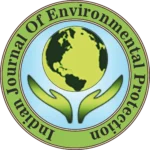IJEP 41(1): 25-33 : Vol. 41 Issue. 1 (January 2021)
Adeline Sneha J.1, Rekha Chakravarthi2*, Nor Hisham Khamis3 and Joshua Amarnath D.4
1. Sathyabama Institute of Science and Technology, Chennai – 600 119, Tamil Nadu, India
2. Sathyabama Institute of Science and Technology, Department of Electronics and Telecommunication Engineering, Chennai – 600 119, Tamil Nadu, India
3. Universiti Teknologi Malaysia, Department of Communication Engineering, Malaysia
4. Sathyabama Institute of Science and Technology, Department of Chemical Engineering, Chennai – 600 119, Tamil Nadu, India
Abstract
The Giant African snail is the world’s largest, destructive and most damaging land pest in agricultural plantations. These pests are sometimes called as the natural enemies of farmers. High devouring capacity of these snails causes heavy damages to vegetation. In this work, various snails are collected and placed in the room temperature. The snails were feed with the consumables, such as cauliflower, tomatoes and soil, indeed the sound frequency is measured. In addition, the various activities also monitored and the respective frequencies are observed. For instance, the movement of a snail, retraction of the head in shell, head movements are recorded from the acoustic room with the recorder. However, monitoring the snail low level sound were challenging for recording. Thus the high precision device is required for recording the signals. The recording has been done for a number of days in order to evade uncertainty. The recorded accurate signals are chosen for the analysis. These signals are analyzed in the time and frequency domain. The statistical features are extracted from the signal. Further, the power spectral density, sound pressure level and equal loudness contour of the signals are calculated. The wide range of frequency of the snail of its various movements is determined. The extracted statistical features from the signals are fed into the neural network for training. Back propagation algorithm is used for classification along with the snail’s signal, few noise signals also fed into the neural network to identify the effectiveness of network in the identification of the pest. It gives 99% efficiency in identifying the snail’s signal. This work is also compared with capacitance based pest identification. This work has been experimentally validated with low-cost acoustic sensor that wirelessly communicates to the base, to monitor and control snail activity, the work suggested in this paper is a non-destructive form of pest identification which does not harm the crops as well as the environment.
Keywords
Pest identification, African snail, Acoustic, Crops protection
References
- Oerke, E.C. 2006. Crop losses to pests. J. Agric. Sci., 44(1): 31-43.
- IUCN SSG. 2012. Global invasive species database. Invasive Species Specialist Group.
- Nelson, S. 2012. The Giant African snail. Hãnai’ Ai/The food provider.
- Sridhar, V., et al. 2013. Severe occurrence of the giant African snail, Achatina fulica (Bowdich) (Stylommatophora: Achatinidae) in Kolar district, Karnataka. Pest Manage. Horticultural Ecosystems. 18(2): 228-230.
- Nelson, S. 2012. Injuries caused by the giant African snail to papaya. College of Tropical Agriculture and Human Resources, University of Hawai’i, Mãnao, United States.
- Raut, S. and G. Barker. 2002. Achatina fulica Bowdich and other achatinidae as pests in tropical agriculture. In Molluscs as crop pests. Ed G.M. Barker. CAB International, Wallingford. pp 55-114.
- Roda, A., et al. 2018. A trapping strategy to aid giant African snail (Lissachatina fulica) eradication programmes. PloS one. 13(9).
- Bagarinao, T. and I. Lantin-Olaguer. 2000. From triphenyltins to integrated management of the pest snail Cerithidea cingulata in mangrove-derived milkfish ponds in the Philippines. Hydrobiologia. 437(1-3):1-6.
- Kulsantiwong, J., et al. 2013. DNA barcode identification of freshwater snails in the family Bithyniidae from Thailand. PloS one. 8(11).
- Ferro, E., et al. 2014. Wireless sensor mote for snail pest detection. Sensors IEEE. DOI: 10.1109/ICSENS. 2014.6984946.
- García-Lesta, D., et al. 2016. Live demonstration: Wireless sensor network for snail pest detection. Proceedings of IEEE International Symposium on Circuits and systems. pp 2371.
- García-Lesta, D., et al. 2015. Capacitance-based wireless sensor mote for snail pest detection. Proceedings of IEEE Sensors applications Symposium. pp 1-6.
- Dunstan, D.J. and D.J. Hodgson. 2014. Snails home. Physica Scripta. 89(6).
- Wu, J.Y., et al. 2014. Identification of optimum scopes of environmental factors for snails using spatial analysis techniques in Dongting lake region, China. Parasites Vectors. 7. DOI: 10.1186/1756-3305-7-216.
- Kristanto, A.H., et al. 2019. Survey on egg and fry production of giant gourami (Osphronemus goramy): Current rearing practices and recommendations for future research. J. World Aquaculture Society. 51(1).
- Emelue, G.U. and E.A. Omonzogbe. 2018. Growth performance of African giant land snails (Archachatina marginata) fed with feed formulated with different calcium sources. Malaysian J. Sustainable Agric., 2(1): 1-4.
- Hausdorf, B. 2018. The giant African snail Lissachatina fulica as potential index fossil for the Anthropocene. Anthropocene. 23: 1-4.
